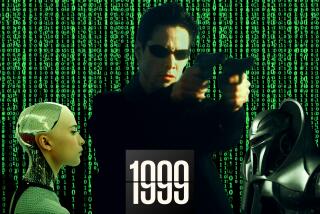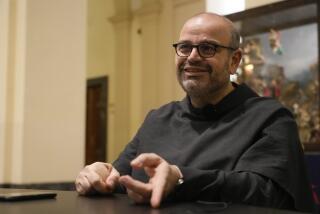Of God and the Machine
David Noble, author of several important books on the history of technology, does not really like his subject. More precisely: He does not like what technologists (inventors, designers, technocrats) do to--and with--their work. In one of his earlier studies, âForces of Production: A Social History of Machine Tool Automation,â he warned against the link between machinery design and employer power: the application of numerical control (taped, mathematically calculated instructions) to automated machinery as a way of depreciating labor skills and undermining craft influence on the production process. He argued then that power was the decisive consideration and that managers and entrepreneurs were ready to adopt a less reliable, even less efficient, technology in order to put down worker control and insubordination. He was premature. Numerical controls have improved faster than he expected.
His latest work resumes this theme of technological abuse but on a much larger, even universal, scale. Strangely enough, I find âThe Religion of Technologyâ more persuasive than his earlier excursions. He begins with the Middle Ages and what he calls âthe ideological weddingâ of European technology and Christian âtranscendence.â The rise of millennial (millenarian) expectations and the anticipation of a return to the state of knowledge that preceded the âFallâ imparted in the middle of the 12th century a holy aura to technological progress. The advancement of the useful arts came to be seen as a way of restoring âmankindâs divinityâ: âTechnology now became . . . eschatology,â he writes. As a result, the arts (in the sense of useful arts and crafts) assumed a dignity and value far beyond what they had enjoyed in classical, pagan times or, for that matter, what they knew in other civilizations. New surpassed old. Filmy visions of progress floated about. Noble cites the 16th century Dominican monk Giordano Bruno:
â[And thus] through emulation of the actions of God and under the direction of spiritual impulse [men] sharpened their wits, invented industries and discovered art. And always, from day to day, by force of necessity, from the depths of the human mind rose new and wonderful inventions. By this means, separating themselves more and more from their animal natures by their busy and zealous employment, they climbed nearer the divine being.â
In writing of this process of sublimation, it was not Nobleâs intention to compare European and non-European technological values and performance. But there it is: He provides us with part of the answer to one of historyâs great questions, namely: Why was Europe different? At the beginning of this period, circa AD 1000, Europe had fallen well behind such civilizations as China in matters technical and material and had much to learn; which it did. (Europe could be shamelessly curious and imitative--a great virtue.) By the time Bruno spoke, Europe was well ahead of the rest of the world in all the most crucial technologies, especially those linked to power (including the power to kill) and the diffusion of knowledge (recourse to printing). Some scholars, in an effort to humble European (Western) pride, have sought to minimize these gains: to argue, for example, that Europe did not take the lead until the Industrial Revolution at the end of the 18th century or that its primacy was the accidental product of discoveries and booty. But none of that fits the facts of knowledge and performance, whereas Nobleâs thesis contributes mightily, if implicitly, to our understanding.
Those millennial visions launched a thousand years of what most people would see as beneficent technological progress. This is not to say that mankind has always used its new power and wealth well, but few people would return to more primitive ways and days. So now where? This is the main theme of Nobleâs book: the continued divinization (and militarization) of mankindâs technological achievements and goals. What are the limits? Should there be limits? And what are the costs? Should we care about costs?
In this respect, he focuses on three areas: space exploration, artificial intelligence and artificial life. He calls attention to the pious enthusiasm of participants and partisans. He cites the passionate affirmations of Christian belief by the American astronauts, the personal baggage of Bibles, wine and wafers, the readings from Genesis, the designation of the 1968 voyage of Apollo 8 as a âmillennial eventâ by Pope Paul VI and the astronautsâ readings from scripture on the voyage. The whole venture is seen not simply as proof of the existence and immanence of God on the moon as on Earth but of humankindâs ability to walk in Godâs path and attain quasi-divine status. After the return of Apollo 11 from the moon, President Nixon boasted: âThis is the greatest work since the beginning of the world, the Creation.â Billy Graham then admonished him that there were three greater events: Christâs birth, crucifixion and resurrection. All of this, Noble reminds the reader, goes back to medieval effusions. Thus the German astronomer Johannes Kepler: âShould the kind of Creator that brought forth nature out of nothing deprive the spirit of man, the master of Creation and the lordâs own image, of every heavenly delight?â
One is not surprised to learn that astronauts are, or become, true believers. âThere is no room for agnostics in Americaâs space and missile program,â said Brig. Gen. Robert Campbell. Ordinary people (the kind who enjoy reading about these things or seeing them on TV) are not likely candidates for such voyages. Space travel calls for enthusiasts. Besides, the voyage itself has to be an exhilarating experience, especially once one returns. What is more momentous is the commitment of scientists, presumably hardheaded, dry-as-dust skeptics, to the pursuit of these and related dreams; to the achievement, for example, of artificial intelligence and artificial life. It is not the work itself that strikes one as farfetched. It is the motivation, the spirit that animates the effort.
This spirit is partly practical and material. Thus intelligent machines make it possible to manufacture watches by the tens and hundreds of thousands in rooms that are empty of people; computer chess programs can defeat mere mortals; and cloned complex organisms, with altered germ plasm, can yield products of considerable value, including materia medica. All of these possibilities, then, have elicited private investment.
But what of scienceâs larger goals? Here Noble has no trouble showing the persistence of faith and dreams that transcend the here and now. He looks for precedents to Descartes and Boole, though he could have found many others of comparable genius-cum-faith (say, Newton); and he cites the work in our time of such eccentrics (should we say?) as Scott Turing, master cryptanalyst, inventor of intelligent machines, pretender to divine creativity. In designing these machines, Turing affirmed, â[W]e are instruments of His will providing mansions for the souls He createsâ; and, perhaps sarcastically, recommended the transmigration of menâs souls to their machines. Turing apparently committed suicide by eating an apple laced with cyanide (what symbolism!). Noble cites Turingâs last postcards, âMessages From the Unseen World.â Some people can see ahead.
Noble shows that much of the work in space exploration, artificial intelligence and artificial life grew out of and was financed by military research. The aim was heaven-to-Earth capacity to detect and destroy; the goals and hopes were unlimited, but so were the fears. How should we respond to similar efforts by the other side? Nuclear holocaust hung over us, hence the need to search for new havens: in the Caribbean to start with (scientist Edward Fredkin built a fortress there for survival in a post-nuclear holocaust world), across space eventually. If much of this sounds like a James Bond movie or âStar Wars,â it is. Meanwhile the artificial-life people saw themselves as enjoying Godâs sanction and sharing his role. They had been granted the gift of genetic knowledge and thereby a part in the process of creation.
For me, the pages of âThe Religion of Technologyâ recall Astounding and Amazing Stories, those pulp magazines that I read as a child, in which imagination had no rein, and fantasy was unlimited for a dime. And maybe this is what it takes to engage in macro-scientific speculation and research.
The difference now is that the dreamers and wizards have big budgets. In the Middle Ages and the Renaissance, some princes financed the useful arts and artists, but these generally had to prove themselves by their practicality: firing a cannon straighter and farther; building a better port; reclaiming wet land and irrigating dry; assembling a better clock. The magicians were left to their hocus-pocus and salable potions. To be sure, it was the state that financed the early voyages of discovery, but there the returns proved large and quick, to the point where private capital pressed to share.
Today, as Noble shows, dreamers are financed, and we are paid in dreams. We nurture (or more precisely, the United States nurtures), in addition to intellectually generated research, a grand array of celestial projects promoted by the military and lauded by a small army of publicity types and lobbyists, scientific âstatesmenâ and the news-hungry media. Many of these publicists are linked to industrial and commercial interests, and all work tirelessly to sell the public on costly adventures that yield piddling discoveries and achievements. Just think: If we find ice on the moon, we should be able to build a space station, whence missiles and containers could travel through the solar system and perhaps find more ice.
The pay-off is ridiculously low, but how can we know? Who can argue against hope? Or against an open-ended commitment to the great scientific adventure? Isnât this commitment the foundation stone of modern civilization? Meanwhile, no one would put his own money in the venture. Indeed, no other country except Russia, a weak nation stuck with earlier projects like Mir, would throw money away for such purposes. That is why it is so useful to have a rich world leader like the United States.
Noble himself does not pursue the implications of his survey, but they seem obvious to this reader, and that may be our authorâs intention. Watch out, he warns us, for Dr. Strangeloves and their warrior accomplices. Just let these blowhards sound off about destroying the enemy and saving the world. But stop financing them. Besides, their sense of tasks and goals is hardly encouraging. They donât enjoy life: If they did, would they come up with visions of humanity lost? Do we really need bodies, asked J.D. Bernal, British âlife scientist,â in his 1929 essay collection âThe World, the Flesh, and the Devil.â âSooner or later man will be forced to decide whether to abandon his body or his life. After all it is the brain that counts,â Bernal wrote.
Such a transcendental fate sounds almost as boring as an eternity of heaven. Read this book.
More to Read
The biggest entertainment stories
Get our big stories about Hollywood, film, television, music, arts, culture and more right in your inbox as soon as they publish.
You may occasionally receive promotional content from the Los Angeles Times.










